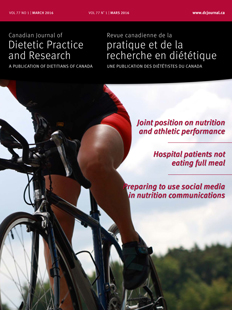Abstract
Purpose: To assess the consumer food environment in restaurants in Saskatoon, using the Nutrition Environment Measures Survey for Restaurants (NEMS-R), to examine differences by neighbourhood distress level and to reflect on the need for further refinement of the assessment of restaurant consumer food environments.
Methods: Neighbourhoods were classified as low, middle, or high distress level based on the socioeconomic indicators (income, employment, and education) in the Material Deprivation Index. Differences in restaurant consumer food environments, indicated by mean NEMS-R total and sub-scores, were examined by various restaurant categories and by varying neighbourhood distress levels.
Results: Chain coffee shops and pita and sandwich restaurants had higher NEMS-R totals and “Healthy Entrées” sub-scores; however, burger and chicken restaurants and pizza restaurants had more barriers to healthful eating. Although restaurants in lower distress level neighbourhoods generally rated healthier (higher NEMS-R scores), only a few measures (such as “Facilitators” and “Barriers”) significantly differed by neighbourhood distress level.
Conclusions: The findings highlight the importance of developing interventions to improve restaurant consumer food environments, especially in neighbourhoods with higher distress levels. The results suggest that reliable measures of the consumer food environment could be developed beginning with what can be measured by NEMS-R.
Résumé
Objectif. Évaluer l’environnement alimentaire du consommateur dans les restaurants de Saskatoon à l’aide de l’outil Nutrition Environment Measures Survey for Restaurants (NEMS-R) afin d’examiner les différences de niveau de détresse par quartier et de réfléchir au besoin d’approfondir l’évaluation des environnements alimentaires du consommateur dans les restaurants.
Méthodes. Un niveau de détresse faible, moyen ou élevé a été attribué à chaque quartier en fonction des indicateurs socio-économiques (revenu, emploi et formation) issus de l’indice de défavorisation matérielle. Les différences d’environnement alimentaire du consommateur dans les restaurants, indiquées au moyen des scores totaux et sous-totaux de l’outil NEMS-R, ont été analysées en fonction des diverses catégories de restaurants et du niveau de détresse des quartiers.
Résultats. Les restaurants spécialisés dans les pitas et sandwichs ainsi que les cafés-restaurants appartenant à des chaînes présentaient des scores totaux NEMS-R et sous-totaux pour la catégorie « plats principaux sains » plus élevés. Les restaurants spécialisés dans les hamburgers, la pizza et le poulet présentaient plus d’obstacles à une saine alimentation. Si les restaurants situés dans des quartiers présentant un niveau de détresse plus faible étaient généralement plus sains (scores NEMS-R plus élevés), seules quelques mesures (« éléments facilitateurs » et « obstacles », p. ex.) différaient de manière importante selon le niveau de détresse du quartier.
Conclusions. Les résultats mettent en lumière l’importance du développement d’interventions destinées à améliorer les environnements alimentaires du consommateur dans les restaurants, particulièrement dans les quartiers présentant un niveau de détresse élevé. Les résultats suggèrent par ailleurs que des mesures fiables de l’environnement alimentaire du consommateur pourraient être mises au point à partir de ce que l'outil NEMS-R permet de mesurer.



